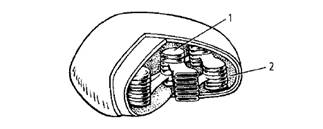
Concept explainers
To identify:
The parts shown in given diagram and state the phase of photosynthesis that occurs in each part.
Introduction:
Photosynthesis is an anabolic pathway in which light energy from the Sun is converted to chemical energy for use by the cell. Light energy is trapped by pigments called chlorophyll and converted to chemical energy during the process of photosynthesis. Photosynthesis occurs in two phases; light dependent reaction and light independent reaction. The light dependent reaction is also called light reaction. Chloroplasts are the organelles which capture light energy.
Answer to Problem 10STP
Part 1 is Thylakoid and part 2 is stroma.
Light dependent reaction occurs in thylakoid and light independent reaction occurs in stroma.
Explanation of Solution
The given diagram shows chloroplasts.

Chloroplasts have two compartments;
Part 1- thylakoid
Flatsac like structures called thylakoids are arranged in stacks called grana.Light reactionsoccur in the thylakoids within the chloroplasts. Thylakoid membranes have a large surface area which provides space to hold large number of electron transporting molecules and two types of protein complexes called photosystem I and photosystem II. These play aimportant roles in light reactions.
Part 2- stroma
A fluid filled space called stroma is present outside the grana. It contains many enzymes needed for carbon fixation. Light independent reactions in phase two of photosynthesis occur in this part. Light energy is converted to chemical energy by electron transport chain that occurs between thylakoid membranes and stroma.ATP is formed in the stroma by the process of chemiosmosis. Next the Calvin cycle occurs in stroma where enzyme RuBisCO fixes the carbon dioxide into 3- carbon molecules called 3- phosphoglycerate (3-PGA). In the next step energy is transferred from ATP and NADPH to 3- phosphoglycerate (3-PGA) to form glyceraldehyde 3- phosphates (G3P). Next two G3P molecules leave the cycle to be used for the production of glucose and other organic compounds.
Chapter 8 Solutions
Biology Illinois Edition (Glencoe Science)
Additional Science Textbook Solutions
Campbell Biology (10th Edition)
Biology: Life on Earth with Physiology (11th Edition)
Campbell Essential Biology (7th Edition)
Human Anatomy & Physiology (2nd Edition)
Microbiology: An Introduction
 Human Anatomy & Physiology (11th Edition)BiologyISBN:9780134580999Author:Elaine N. Marieb, Katja N. HoehnPublisher:PEARSON
Human Anatomy & Physiology (11th Edition)BiologyISBN:9780134580999Author:Elaine N. Marieb, Katja N. HoehnPublisher:PEARSON Biology 2eBiologyISBN:9781947172517Author:Matthew Douglas, Jung Choi, Mary Ann ClarkPublisher:OpenStax
Biology 2eBiologyISBN:9781947172517Author:Matthew Douglas, Jung Choi, Mary Ann ClarkPublisher:OpenStax Anatomy & PhysiologyBiologyISBN:9781259398629Author:McKinley, Michael P., O'loughlin, Valerie Dean, Bidle, Theresa StouterPublisher:Mcgraw Hill Education,
Anatomy & PhysiologyBiologyISBN:9781259398629Author:McKinley, Michael P., O'loughlin, Valerie Dean, Bidle, Theresa StouterPublisher:Mcgraw Hill Education, Molecular Biology of the Cell (Sixth Edition)BiologyISBN:9780815344322Author:Bruce Alberts, Alexander D. Johnson, Julian Lewis, David Morgan, Martin Raff, Keith Roberts, Peter WalterPublisher:W. W. Norton & Company
Molecular Biology of the Cell (Sixth Edition)BiologyISBN:9780815344322Author:Bruce Alberts, Alexander D. Johnson, Julian Lewis, David Morgan, Martin Raff, Keith Roberts, Peter WalterPublisher:W. W. Norton & Company Laboratory Manual For Human Anatomy & PhysiologyBiologyISBN:9781260159363Author:Martin, Terry R., Prentice-craver, CynthiaPublisher:McGraw-Hill Publishing Co.
Laboratory Manual For Human Anatomy & PhysiologyBiologyISBN:9781260159363Author:Martin, Terry R., Prentice-craver, CynthiaPublisher:McGraw-Hill Publishing Co. Inquiry Into Life (16th Edition)BiologyISBN:9781260231700Author:Sylvia S. Mader, Michael WindelspechtPublisher:McGraw Hill Education
Inquiry Into Life (16th Edition)BiologyISBN:9781260231700Author:Sylvia S. Mader, Michael WindelspechtPublisher:McGraw Hill Education





